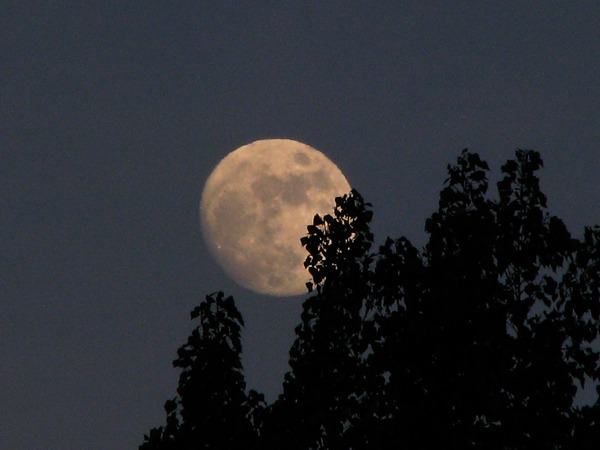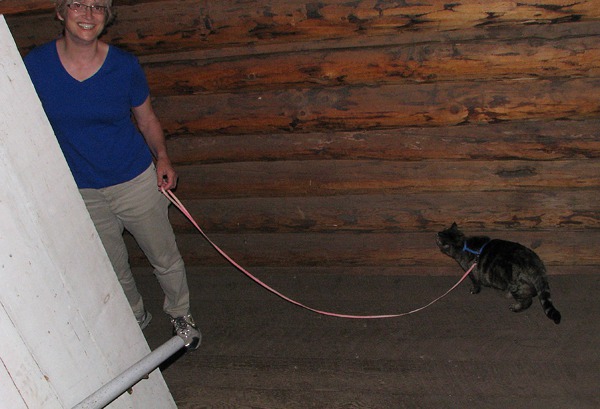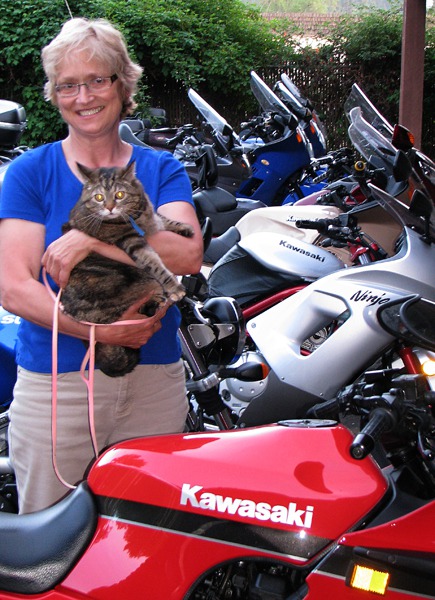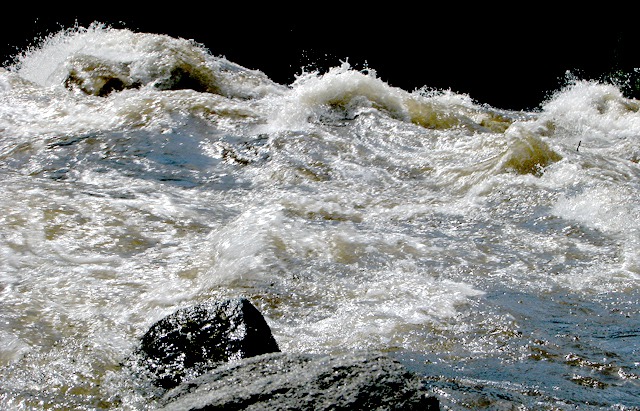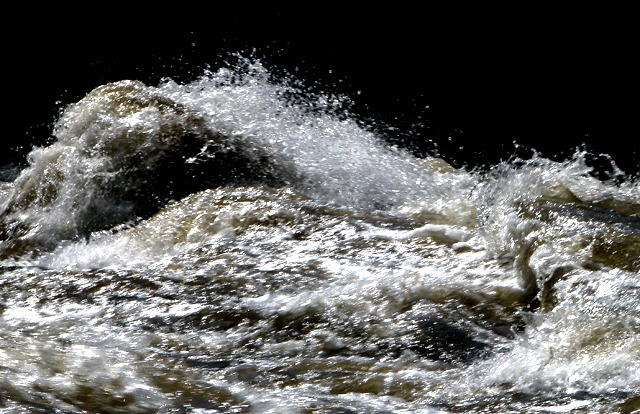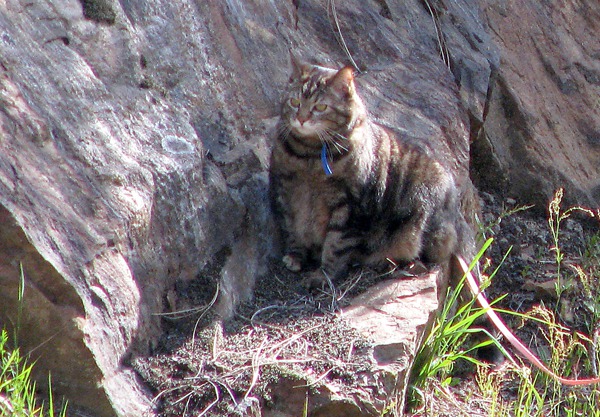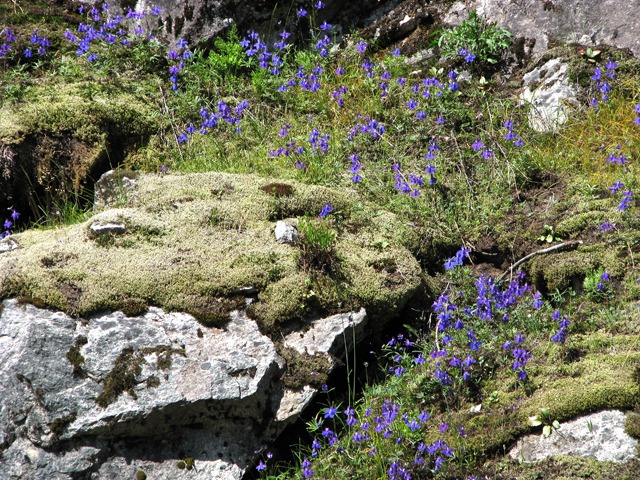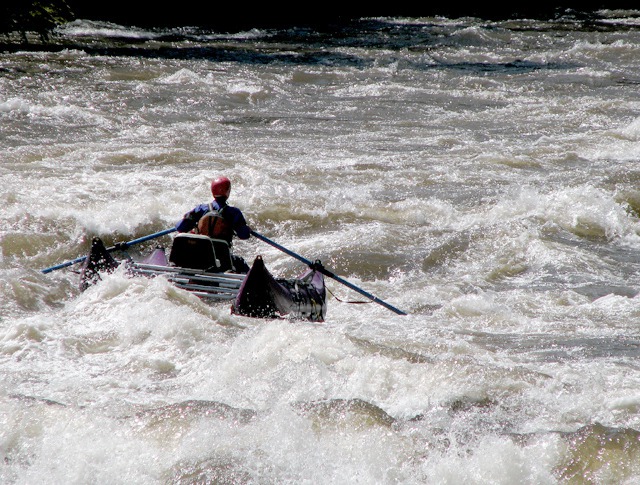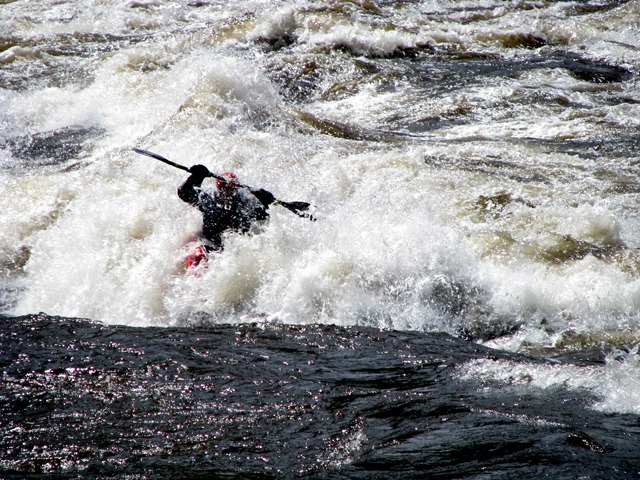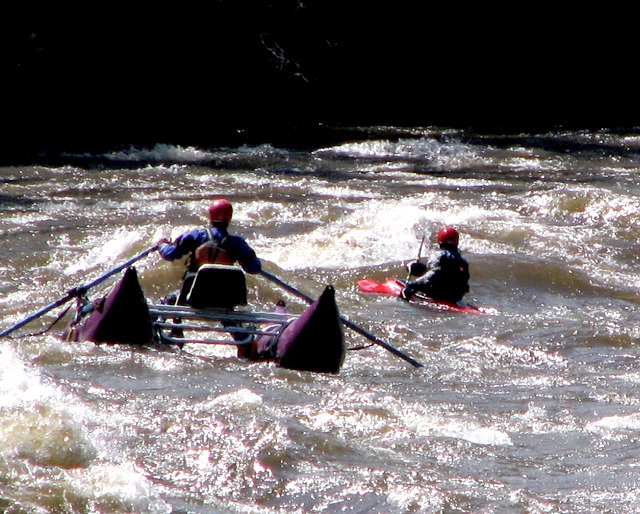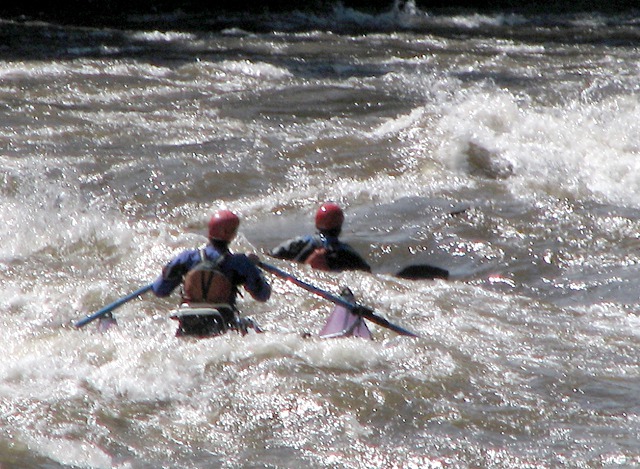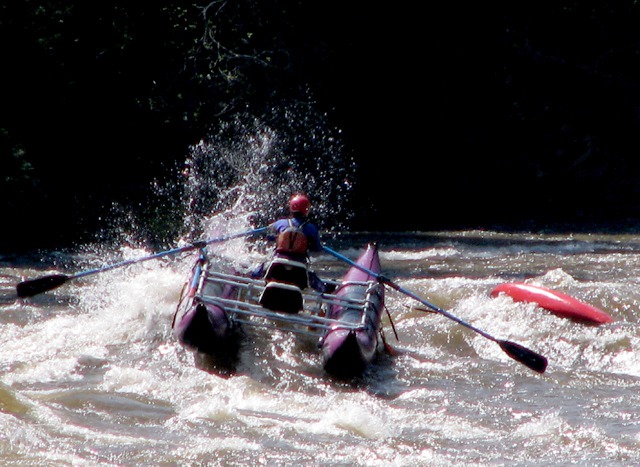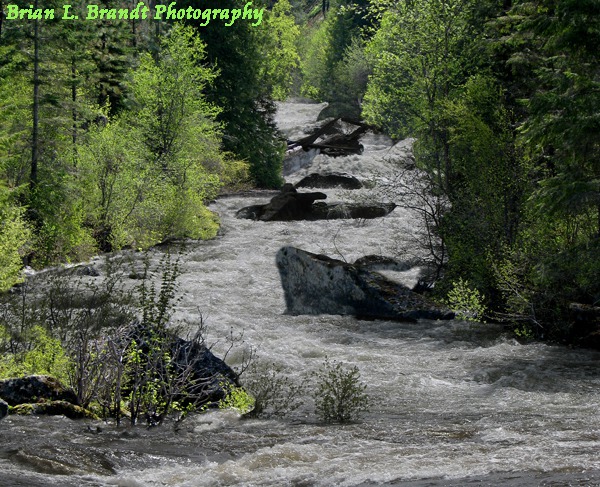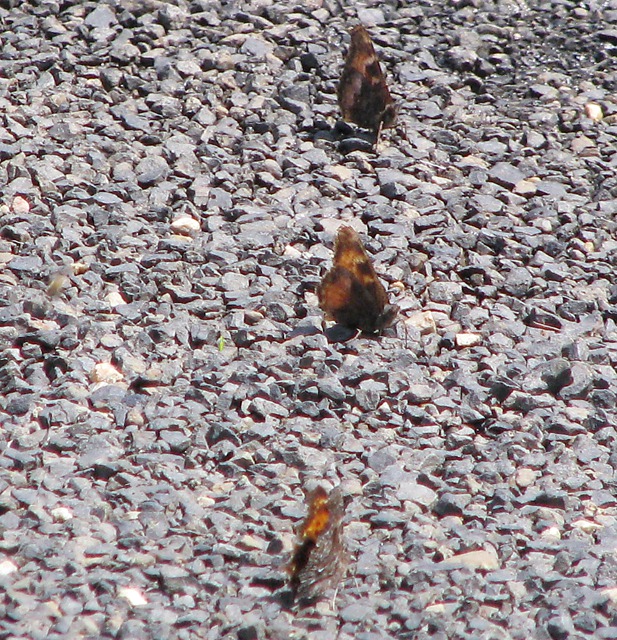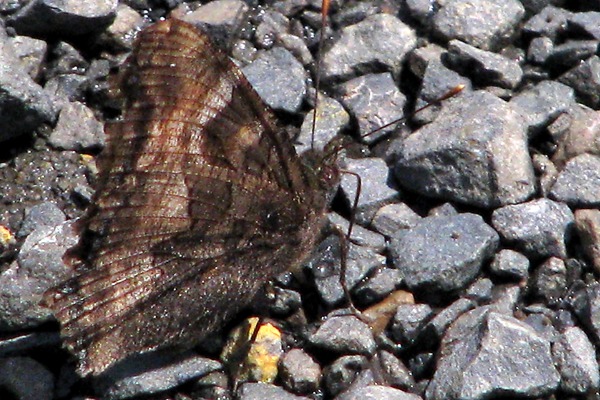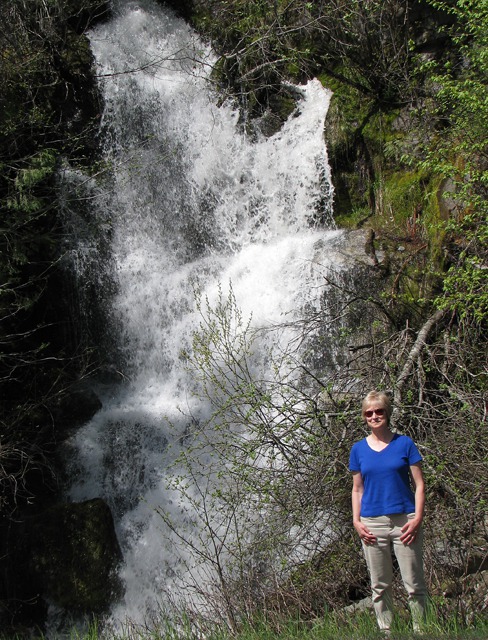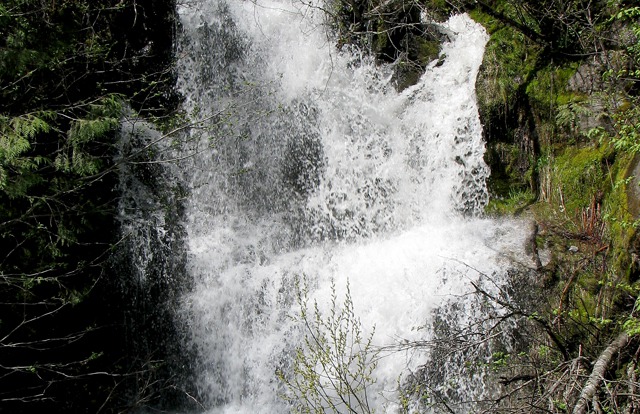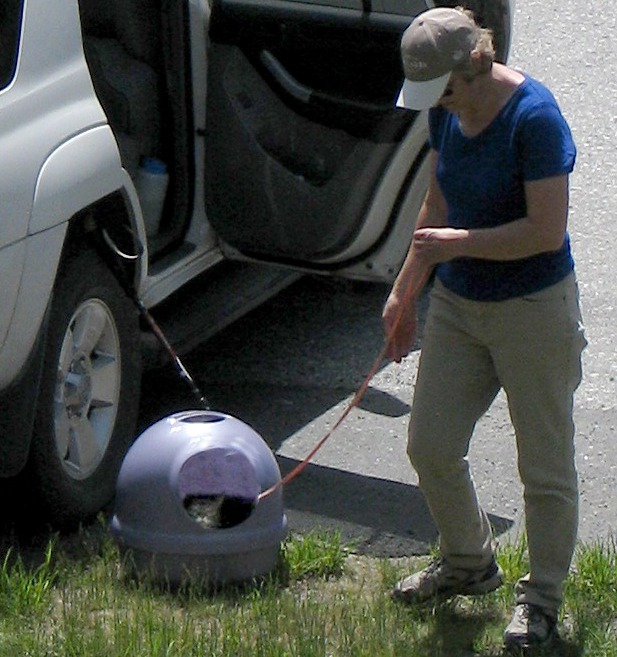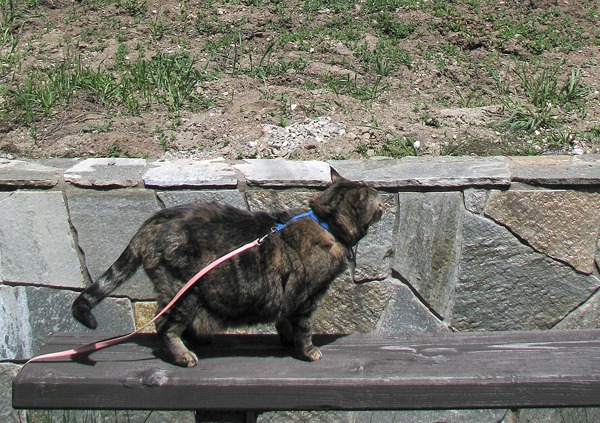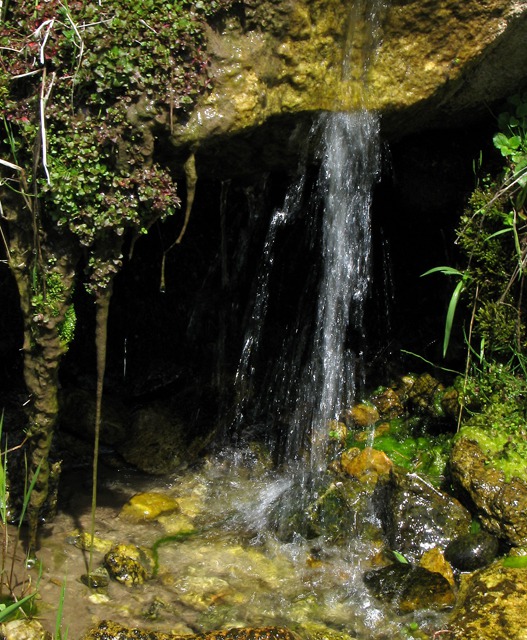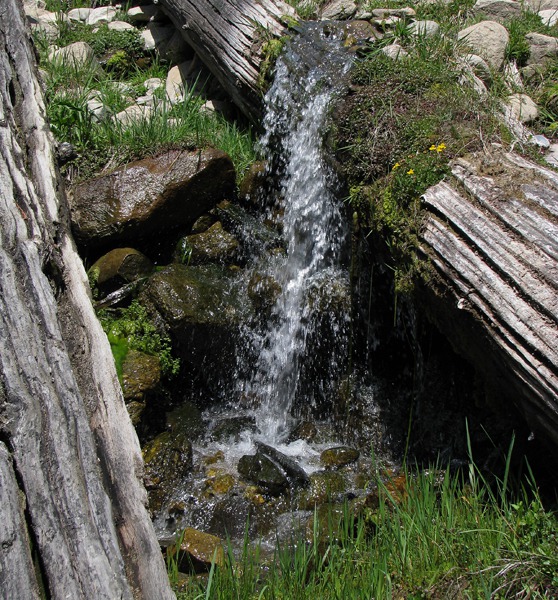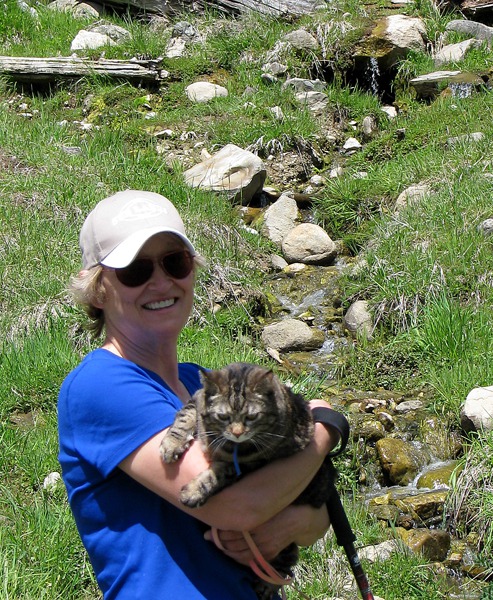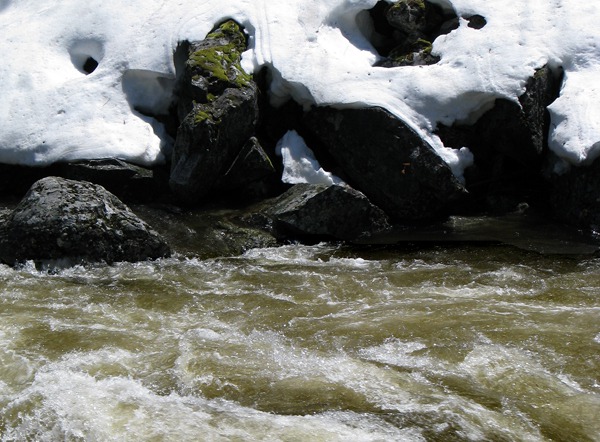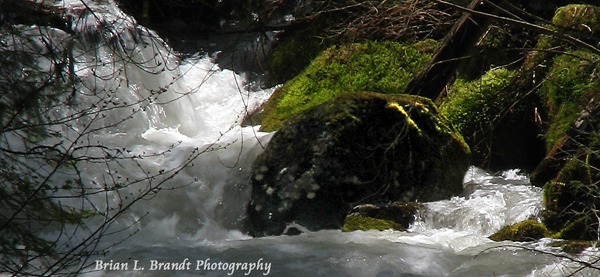By the time we got to the Lewis and Clark resort in Kamaih, it was nearing dusk. An hour later, a huge full moon rose over the trees. Leesha enjoyed a long walk in the trees and grass on the wild edge of the resort. A motorcycle club from Lewiston was also enjoying a group vacation. Leesha was a big hit with the bikers and earned lots of pets.
The resort rooms were so clean that Furry didn't find anything to sniff. Odd. At least odd until we met the main housekeeper the next morning. Germanic and obviously both proud of the work her crew did and efficient. Furry did like the smell of the logs in the stairwell, however.
We rolled out of the resort as the motorcyclists were getting to roll as well. Just before we headed up the Clearwater River, Louise and Furry posed with the bikes.
Louise also took a walk to the Heart of the Monster, a Nez Perce sacred site that's one of thirty-eight sites in the Nez Perce National Historic Park. Sites include the Big Hole Battlefield and the Bear Paw Battlefield. The Nez Perce National Historic Trail is here, too, and stretches from Wallowa Lake, Oregon, to the Bear Paw Battlefield near Chinook, Montana. The trail follows the route of the 1877 flight of the Nez Perce from their homelands while pursued by U.S. Army Generals Howard, Sturgis, and Miles. This is one of the most fascinating and sorrowful events in Western U.S. history. Chief Joseph, Chief Looking Glass, Chief White Bird, Chief Ollokot, Chief Lean Elk, and others led nearly 750 Nez Perce men, women, and children and twice that many horses over 1,170 miles through the mountains, on a trip that lasted from June to October of 1877. The creation legend: Coyote was building a fish ladder at Celilo [Falls,Oregon]. He was busy at this when someone shouted to him, “Why are you bothering with that? All of the people are gone” “Well,” said Coyote to himself, “then I’ll stop doing this because I was doing it for the people, and now I’ll go along too.” From there he went along upstream, by way of the Salmon River country. Along the way he took a good bath saying to himself, “Lest I make myself repulsive to his taste,” and then dressed himself all up, “Lest he will vomit me up or spit me out.” There he tied himself with rope to three mountains. From there he came along up and over the ridges. Suddenly, he saw a great head. He quickly hid himself in the grass and gazed at it. Never before in his life had he seen anything like it; never such a large thing – away off somewhere melting into the horizon was its gigantic body. Coyote shouted to him, “Oh Monster we are going to inhale each other!” The big eyes of the monster roved around looking all over for Coyote but did not find him, because Coyote’s body was painted with clay to achieve a perfect protective coloring in the grass. Coyote had on his back a pack consisting of five stone knives, some pure pitch, and a flint fire making set. Presently Coyote shook the grass to and fro and shouted again, “Monster! We are going to inhale each other.” Powerfully and noisily he drew in his first breath and the great monster just swayed and quivered. Then Coyote said, “Now you inhale me, for already you have swallowed all the people, so swallow me too lest I become lonely.” Now the Monster inhaled like a mighty wind. Thus he dashed right into the monster’s mouth. From there he walked along down the throat of the monster. Presently Coyote arrived at the heart and cut off slabs of fat and threw them to the people. And now Coyote started a fire with his flint, and smoke drifted up through the monster’s openings. There was his fire still burning near the heart and now the monster began to writhe in pain and Coyote began cutting away on the heart, whereupon very shortly he broke the stone knife. Immediately he took another and in a short time this one also broke and Coyote said to all the people, “Gather up all the bones and carry them to his openings; pile them up and when he falls dead kick all the bones outside.” Then again with another knife he began cutting away at the heart. The third knife broke and the fourth, leaving only one more. Now the heart hung by only a very small piece of muscle and Coyote was cutting away on it with his last stone knife. The monster’s heart was still barely hanging when his last knife broke whereupon Coyote threw himself on the heart and hung on just barely tearing it loose with his hands. In his death convulsions the monster opened all the openings of his body and now the people kicked the bones outside and went on out. They carved the great monster and now Coyote began dealing out portions of the body to various parts of the country all over the land; toward the sunrise. Toward the sunset, toward the warmth, toward the cold, and by that act destining and forenaming the various people; Coeur d’Alene, Cayuse, Pend Oreilles, Flathead, Blackfeet, Crow, Sioux, et al. And now Fox came up to Coyote, “What is the meaning of this, Coyote? You have distributed all of the body to faraway lands but have given yourself nothing for this immediate locality.” And he turned to the people and said, “Bring me some water with which to wash my hands.” They brought him water and he washed his hands and now with the bloody wash water he sprinkled the local regions saying, “You may be little people but you will be powerful. Even though you will be little people because I have deprived you, nevertheless you will be very, very, manly. Only a short time away is the coming of the human race.” Louise listened to the legend at the audio sites along the trail. In addition to being a legend site, this area was also used by the Nez Perce to cross the Clearwater River. Now we were on the Lewis and Clark Scenic highway -- US 12 along the Clearwater and Lochsa Rivers through the Lochsa River canyon. Lewis and Clark almost starved to death on this part of their journey; the Nez Perce fed and saved them. Construction of the highway began in the early 1900s on both east and west ends. Work continued over the years until the highway opened in 1961.The Clearwater/Lochsa rivers weren't clear this time of year for sure, but they were roaring at 42,000 cubic feet per second. Just for comparison, at the record low flow, the Clearwater was at 100 cubic feet per second. Forest Service signs warned people not to try to kayak or float it. Of course, they were anyway. It was flowing so violently that standing at the very edge of the water was even a little disorienting, and not for weak swimmers.
Furry had the good sense not to get out on the river side of the road at all. She finally agreed to take a little stretch break on the roadside away from the river, but wasn't liking the roar much at all.
After a short walk she found a ledge on the cliff and settled in for a good sniffing session. That's as close to the river as she'd get.
Further along, the canyon was alive with larkspur in huge swatches across the moss and rocks.
A little later we were stopped at another roadside spot, and heard yelling coming from the river. A guy on a pontoon boat and a guy in a kayak were ignoring the warnings of the danger of the river -- of course, it was amazing white water at the same time -- and they blasted past us.
I'm sure there were a few "hope I have on clean underwear for when they find me" moments (what seemed like minutes) as the kayaker bounced his clad noggin on submerged rocks before he was able to roll his kayak back up and pull to shore (at that point, perhaps to clean his underwear.)
It's one of those moments where your thought process goes like this: "If they are really expert enough to be out here in this, then I'm not going to worry. If they are not expert enough to be out here in this, I'm not going to worry because, a) the gene pool just got cleansed, and b) there's nothing I can do about it anyway."
Not only was the main river ripping past but the side canyon creeks were frothing as they crossed under the road or came into the river.
- A Side-Canyon Creek Near Where the Selway River Joins the Lochsa at Lowell to Make the Middle Fork of the Clearwater
Across the road from the butterflies was a sizeable waterfall that was running full force -- Tumble Creek Falls
Further up river we lowered Furry's little purple house to the ground so she could decide whether to go for a another little cat walk. Next we stopped at Colgate Licks, named for George Colgate, guide for the ill-fated Carlin hunting party who got snow bound and had to eventually be rescued from deep snow by a military expedition (Carlin was the son of an Army general.) Colgate died here in 1893 after being abandoned by his big-city clients when they determined he was too sick to care for or to take with them as they fought their way through deep snow to try to find their way back down the Clearwater. Another party found Colgate's scattered remains the next spring a long way from where his clients left him and at the end of what appeared to be a long crawl as he tried to follow his clients out on his hands and knees. The story became the focal point for a controversial series of newspaper articles and the inspiration of a fictional account of the episode called "Snowbound." The "Licks" part of the name comes from natural mineral deposits or "licks" that are found in the area. The site has a ½-mile National Recreation Trail through cedar snags, charred from fires that swept the area decades ago. The side hill was literally awash with small rivulets that cascaded down over grass, logs, and moss, forming dozens of little waterfall vignettes. A mineral spring flows at the top of the ridge. Furry got out and went to sit on a bench while I took photos on the hill a few feet away and Louise took the opportunity to hike the nature trail.
- Furry Gets Benched
Finally Louise came back from her hike, and loaded up Furry and we went on up river toward Lolo Pass.
As we went further up river, the moss was wrapped around dead limbs, and snow came right to the riverbank.
Creeks continued to add to the river from both sides of the road. The river narrowed as we started out climb to Lolo Pass - still buried in snow as you'll see in the next post in the series. Text and photos by Brian. Text and research by Louise. Copyright GoinMobyle, LLC, 2011


